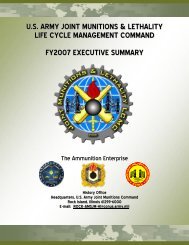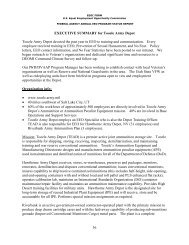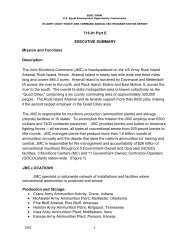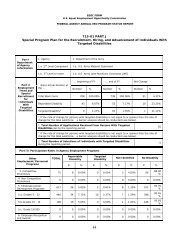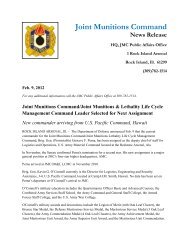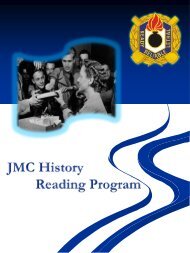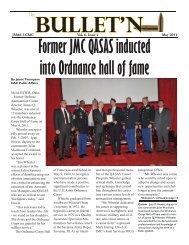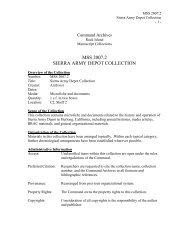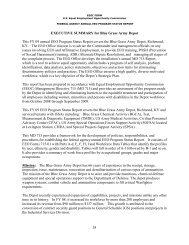History of the Ammunition Industrial Base - JMC - U.S. Army
History of the Ammunition Industrial Base - JMC - U.S. Army
History of the Ammunition Industrial Base - JMC - U.S. Army
Create successful ePaper yourself
Turn your PDF publications into a flip-book with our unique Google optimized e-Paper software.
After September 2001, DA decision makers had to contend with potential ammunition<br />
shortages. The true impact <strong>of</strong> Condition Codes E, F, K, and N was that ammunition <strong>the</strong> DA<br />
leadership thought was available could not be used for combat without inspection and<br />
maintenance. 171 Resources in <strong>the</strong> POM could buy about 45% <strong>of</strong> <strong>the</strong> shortfall items. Due to <strong>the</strong><br />
atrophying <strong>of</strong> <strong>the</strong> ammunition base in <strong>the</strong> 1980s and 1990s, surge operations could affect only<br />
10% <strong>of</strong> <strong>the</strong> go-to-war shortfalls. To activate laid-away plants would take between seven and<br />
thirteen months. 172 <strong>Army</strong> decision makers made difficult decisions, but <strong>the</strong>y needed to never<br />
again be in <strong>the</strong> position <strong>of</strong> being unaware <strong>of</strong> <strong>the</strong> true status <strong>of</strong> <strong>the</strong> ammunition stockpile.<br />
MG McManus returned from that meeting with <strong>the</strong> idea <strong>of</strong> creating a munitions reporting<br />
system focused on readiness and <strong>the</strong> Warfighter, not <strong>the</strong> POM and budget. He wanted a system<br />
to show decision makers <strong>the</strong>ir options and choices framed in a familiar looking system. OSC<br />
immediately began <strong>the</strong> development <strong>of</strong> <strong>the</strong> Munitions Readiness Report (MRR) as part <strong>of</strong> <strong>the</strong><br />
Strategic Readiness System (SRS). The MRR calculates ammunition readiness, production,<br />
quality, and serviceability for each ammunition item and family and projects readiness for 24<br />
months into <strong>the</strong> future. Readiness ratings are assigned based on <strong>the</strong> worst readiness rating<br />
among <strong>the</strong>se four areas after using standardized computations. In addition, <strong>the</strong> system highlights<br />
which ammunition items are used by <strong>the</strong> joint forces. The data in <strong>the</strong> MRR includes both<br />
missiles and conventional ammunition. It measures <strong>Army</strong> worldwide capability in specific<br />
munitions categories, such as small arms, mortars, tank main gun, or cannon artillery. In every<br />
category each specific ammunition item is tracked. For example, in <strong>the</strong> small arms category, <strong>the</strong><br />
MRR tracks 5.56mm, 7.52mm, .50 caliber, etc. in every configuration. Newer items <strong>of</strong><br />
munitions, not yet transitioned to National Inventory Control Point (NICP) management, are<br />
included as well. The data included is <strong>the</strong> result <strong>of</strong> a collaboration involving input from many<br />
agencies.<br />
From 2002 to 2004, <strong>JMC</strong> updated this data quarterly, with interim flasher reports<br />
whenever significant events impacted readiness. In 2005 <strong>the</strong> readiness team began a monthly<br />
update to <strong>the</strong> database. The MRR ratings now projected out to predict <strong>the</strong> ratings in six, twelve,<br />
eighteen, and twenty-four month projections using statistical production models based on usage.<br />
The online database also provided <strong>the</strong> ability to “drill down” to individual munitions categories<br />
to explore <strong>the</strong> key issues, components, or pieces driving readiness. 173<br />
In 2006 <strong>JMC</strong>‟s Readiness Directorate refined <strong>the</strong> depiction <strong>of</strong> <strong>the</strong> ammunition status.<br />
Reporting <strong>of</strong> <strong>the</strong> MRR provided a single ammunition common operating picture (COP) or one<br />
voice to decision makers. The MRR was shown differently within <strong>the</strong> Balcony Brief, a briefing<br />
to <strong>the</strong> Vice Chief <strong>of</strong> Staff <strong>of</strong> <strong>the</strong> <strong>Army</strong> at HQDA. The view referred to as <strong>the</strong> Single<br />
<strong>Ammunition</strong> Common Operating Picture (COP) provided a monthly worldwide munitions status<br />
and have a predictive capability forecast out to 24 months for <strong>the</strong> Balcony Brief. The data<br />
171 Condition Codes represent <strong>the</strong> availability <strong>of</strong> stock for issue, not just on hand. CC A, B, and C can be issued.<br />
However, CCs E and F need light or extensive maintenance; CC J is suspended ei<strong>the</strong>r due to a known problem or<br />
simply because two or more scheduled inspections have been missed; CC K means that items have been returned<br />
but never inspected to determine serviceability (many Desert Storm returns remain in this category); and CC N<br />
means items can be issued for emergency combat use only. See FM 4-30.13 <strong>Ammunition</strong> Handbook:<br />
Techniques, Tactics and Procedures for Munitions Handlers.<br />
172 Op cit, slides 4 and 16.<br />
173 OSC <strong>History</strong> Office, Annual Command <strong>History</strong>, FY2002: 4, 262. See also Jamieson, Edward, OSC briefing,<br />
“<strong>Army</strong> Munitions Readiness,” 9 August 2002.<br />
57



